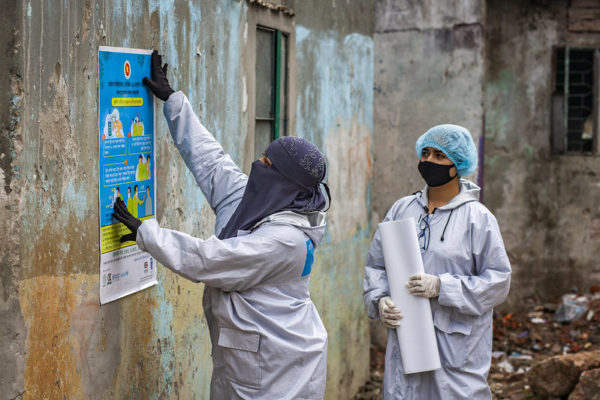
COVID-19 and the future for Bangladesh’s poultry sector
Published on 08/09/2020

UN Women/Fahad Abdullah Kaizer CC By 2.0
More than six million people in Bangladesh are directly or indirectly involved in poultry production. The commercial sector has been expanding rapidly, with commercial poultry farms growing at a rate of 15% a year, providing one significant pathway for the country’s economic development and an increasingly important means to provide nutrition for its people. Poultry farming has also long provided a well-trodden pathway out of poverty for many.
As researchers working closely with chicken farmers, we wanted to find out to what extent the sector was affected by the COVID-19 crisis – in particular, how the pandemic and pandemic control measures were affecting the production, distribution and consumption of chickens and eggs.
We interviewed 36 chicken farmers, traders, feed, medicine and chick suppliers, and others involved in the chicken production and distribution network in Bangladesh, from early April to early May this year. Our findings illustrate the very serious adverse effects that COVID-19 has had on this important, growing sector.
Damaging rumours
In Bangladesh, the first human case of SARS coronavirus-2 was detected on 8 March. By the time lockdown was announced on 26 March there were 39 reported cases. To prevent human-to-human transmission, preventive measures were quickly introduced, including social distancing and controls on people’s movements, closure of food outlets, factories and markets, and reduction of domestic and international transport.
We found that rumours, particularly on social media, that the SARS coronavirus could be transmitted to people through livestock and livestock products, combined with the new lockdown measures, caused serious damage in the different poultry production and distribution networks in the country. For example, poultry farmers stopped receiving necessary supplies such as day-old chicks, poultry feed vaccines and medicines, and a lack of consumer demand –caused by fears from the unfounded rumours as well as people’s decreased incomes and their inability to access markets – meant they could no longer sell their market-ready birds at desired prices.
One medium-scale broiler farmer we interviewed said:
In the last 10 years, I have never experienced this kind of critical situation. I cannot sell mature broilers to middlemen, even at BDT80-90 /kg (US$.95-1.06)) but my production cost is more than BDT100/kg (US$1.20).
As a result, farmers have suffered serious economic losses. Our preliminary research finding shows that by the end of April, approximately 70% of small-to-medium-scale broiler farms had temporarily stopped farming and trading. Although by June, half of these farms had restocked with day-old chicks, it was at a smaller scale due to the uncertainty surrounding the likelihood of further losses.
Economic losses
The plight of farmers in turn significantly affected the business of poultry traders (intermediaries and feed dealers), large poultry companies, poultry feed companies and pharmaceutical companies. Our follow-up study in June showed there was a 30-45% reduction in day-old chick production, a 35-40% reduction in poultry feed production and a 40-50% reduction in the sale of medicines and other pharmaceutical products.
In April, one hatchery manager told us:
The market price of day-old chicks has dropped below the production cost. Now, day-old chicks’ selling price is BDT4-5 (US$0.047-0.05), whereas it was around BDT35 (US$ 0.4) before COVID-19. Our production cost is around BDT30-32 (US$0.36-00.38)). So, we had to reduce day-old chick production to 7.5-8 million from 13 million weekly.
Since the pandemic, farm eggs have been selling at up to BDT4-5.5 (US$0.046-0.065) each at farm level in Bangladesh, against production costs of at least BDT6 (US$ 0.07). The average price of a farm egg was BDT7-8 (US$0.08-0.09) before the pandemic. The production cost per kilogram of broiler meat was BDT95-100 (US$1.17-1.18) while post-pandemic farmers had to sell wholesale for only BDT65-70 (US$0.77-0.80). Farmers, who run their farms by taking credit from the feed dealers, have fallen into more debt.
Price fluctuations
Local newspapers have reported that prices of both chicken eggs and meat hit a 12-year low in April. The Bangladesh Poultry Industries Central Council (BPICC) is expecting the supply-demand mismatch for poultry to continue for a minimum of six months.
In the second week of May, the price of poultry meat and eggs increased as a result of supply disruptions and demand from the Eid-ul-Fitre (one of the biggest Muslim festivals), and according to the state-run Trading Corporation of Bangladesh (TCB), chicken broiler prices increased by an average of 45% in the four days between 20-23 May as Bangladeshi poultry producers had stopped production in March and April due to low demand worsened the situation. Such rapid price fluctuations of poultry meat and eggs are making it increasingly difficult for farmers and traders to cope with the crisis.
One trader interviewed said:
Sell-volume is reducing with the drop in price and supply. But you know, my operational cost isn’t decreased. I have to pay shop rent, the salaries of the staff, utility bills, etc. In the last three months, I had losses of around BDT 0.4 to 0.45 million (US$4,700-5,300) from my capital.
It is estimated that today in Bangladesh 1 million entrepreneurs and 8 million people commercially produce more than 10 billion eggs and nearly 1.5 million tons of poultry meat a year. Pre-coronavirus, commercial poultry farms had been gearing up for exporting by 2024. That development trajectory seems now to be jeopardised.
Livelihoods threatened
In April, BPICC also anticipated that more than two million people in the poultry industry would become unemployed in the next couple of months if the COVID-19 situation does not improve.
Furthermore, the current situation seriously undermines the livelihoods of Bangladesh’s millions of backyard poultry farmers and smaller traders. About 90% of rural Bangladeshi households keep poultry, the practice being recognised as a major pathway for poverty reduction, particularly for poor, landless women
The Bangladesh Government has acted to support the country’s farmers during the COVID-19 period, with measures including Department of Livestock Services (DLS) and Ministry of Livestock and Fisheries (MoFL) support in distributing and marketing eggs and poultry, and MoLF support for the early release of imported items of poultry feed and pharmaceutical products from the seaport.
The Government has also declared a stimulus package of Tk5,000 crore (US$595 million) to provide financial assistance to small and medium farmers in rural areas for boosting agricultural production facing the fallout of COVID-19.
However, Government support alone is not sufficient to repair the damage caused to farmers, and in particular there are complexities linked to the implementation of its stimulus package. A simple but efficient way for farmers to benefit from the package needs to be put forward.
Large poultry companies and UN organisations should come forward. There are no quick solutions to the challenges that the poultry sector has been facing during the COVID-19 crisis in Bangladesh. The sector now needs a short-, medium- and long-term plan to overcome the crisis.
- The author would like to thank Hub researchers Md. Ahasanul Hoque, Md. Helal Uddin, Nusrat Irin, Abdullah Al Sattar and Guillaume Fournié, and Hub Director Fiona Tomley for their contributions to this piece.


